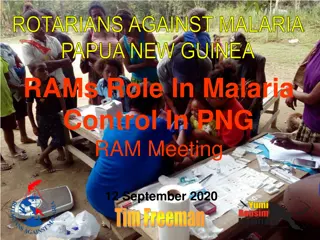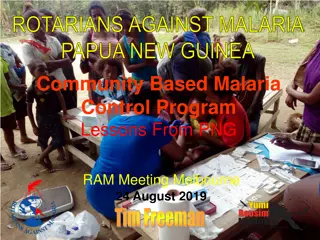Nigeria Year 1 Update Summary - Malaria Prevention Program
In 2015, the Malaria Prevention Program in Nigeria achieved significant milestones under the leadership of Dr. Jamilu Ibrahim Nikau. Activities included training of health workers, distributors, and SMC cycles. Delivery methods involved door-to-door and fixed points approaches. The program covered Sokoto and Zamfara states. Training sessions were conducted for various stakeholders, with materials distributed accordingly. Recommendations were made to improve the effectiveness of job aids for CHWs.
Download Presentation

Please find below an Image/Link to download the presentation.
The content on the website is provided AS IS for your information and personal use only. It may not be sold, licensed, or shared on other websites without obtaining consent from the author.If you encounter any issues during the download, it is possible that the publisher has removed the file from their server.
You are allowed to download the files provided on this website for personal or commercial use, subject to the condition that they are used lawfully. All files are the property of their respective owners.
The content on the website is provided AS IS for your information and personal use only. It may not be sold, licensed, or shared on other websites without obtaining consent from the author.
E N D
Presentation Transcript
Year 1 update Nigeria Dr Jamilu Ibrahim Nikau SMC Focal Person, NMEP [Date] 1
2015 Round Summary Mar 2015 Apr 2015 May 2015 Jun 2015 Jul 2015 Aug 2015 Sep 2015 Oct 2015 Nov 2015 Dec 2015 Jan 2016 Planned 1 2 3 4 5 6 11 7 9 8 10 Actual 4 1 2 3 5 6 7 11 9 8 10 1. 2. 3. 4. Dakar meeting Official kickoff in-country Micro-planning ToT 5. Training of health workers 6. Training of distributors 7-10. SMC cycles 11. Lessons learned Key Accomplishments Upcoming Outstanding Activities Number of trainers trained: TBD Number of health staff trained: TBD Number of volunteers trained: TBD Peak number of children reached: TBD Key Milestones Legend Grey Originally planned Green Completed as planned Yellow Acceptable delay Red Excessive delay 2
Delivery methods & approaches Door-to-door and fixed points approaches are used for the drugs distribution. There are Number of fixed teams = 667, House to House teams =1,827, Health facilities = 371 Composition of distributors teams (per type of approach) Fixed post = 3/team House to House = 2/team Health facilities = 3/team Health workers working in HF were trained and engaged during the distribution, and HF served points for managing ADR
Name of State Numb er of LGA Superv isors Team Ward supervi sor Health Faciliti es Qualifi ed as Fixed Point Numb er of CHWs Numb er of CHWs for Fixed Point Numb er of CHWs for HH Numb er of Comm unity Mobili zers Numb er of Town Annou ncers Numb er of CHWs Team Numb er of HH team Sokoto 214 107 336 3445 1506 1939 321 321 502 970 Zamfara 191 74 341 3156 1442 1714 222 222 481 857 Total 405 181 677 6601 2947 3653 543 543 982 1827 4
Training and materials (I) Training People trained [list by category] Master trainers 25 4 days LGA Supervisory team 405 2 days Ward Supervisors 181 2 days HF Staff 1354 2 days CHWs 6601 3 days Community Mobilizers 543 1 day Town Announcers 543 1 day Materials distributed (job aids, training manuals, flyers & posters, etc.) [list by category] dsds Job aids, National TRAINERS TRAINING REPORT TEMPLATE RMC TRAINING EVALUATION SUMMARY TEMPLATE TOT WORKBOOK FOR National TRAINERS National TRAINER TOT CERTIFICATE RMC TRAINER GUIDE SMC 5
Training and materials (II) Training were conducted using developed training manuals, job aids and other materials at the National, state and the step down trainings. Job aids are particularly useful to CHW and the health workers. It was not effectively used by all the CHWs because they felt they know it all. The recommendation is that all the fixed post should be converted to house-to-house and the number of supervisors should be increased, also more female supervisors should be engaged and health worker should be used as supervisors. 6
Admin Coverage Summary (I) 1st? Cycle 2nd? Cycle 3rd? Cycle 4th? Cycle Region/State District/LGA Target Reached 65,104 ? ? ? ? ? 48,063 ? ? ? ? ? 24,438 ? ? ? ? ? 56,206 ? ? ? ? ? 39,009 ? ? ? ? ? 37,783 ? ? ? ? ? 55,400 ? ? ? ? ? 28,407 ? ? ? ? ? 42,940 ? ? ? ? ? 42,980 ? ? ? ? ? 440,330 ? ? Coverage 109% 110% 106% 101% 111% 104% 111% 104% 99% 110% 107% Reached 65,422 48,011 23,849 55,887 30,015 43,927 53,550 28,274 41,865 38,431 429,231 Coverage 109% 109% 104% 100% 85% 121% 107% 103% 97% 98% 104% Reached 65,854 50,193 25,000 61,169 37,012 45,654 55,260 29,048 42,677 42,508 454,375 ? ? Coverage 110.21% 114.40% 108.71% 109.85% 105.25% 126.04% 110.59% 106.00% 98.72% 108.81% 109.92% Reached 66,158 ? ? ? ? ? ? ? ? ? ? 47,638 ? ? ? ? ? ? ? ? ? ? 24,485 ? ? ? ? ? ? ? ? ? ? 63,207 ? ? ? ? ? ? ? ? ? ? 39,689 ? ? ? ? ? ? ? ? ? ? 41,327 ? ? ? ? ? ? ? ? ? ? 53,374 ? ? ? ? ? ? ? ? ? ? 27,772 ? ? ? ? ? ? ? ? ? ? 42,188 ? ? ? ? ? ? ? ? ? ? 40,480 ? ? ? ? ? ? ? ? ? ? 446,318 ? ? ? ? ? ? ? ? Coverage 111% 109% 106% 114% 113% 114% 107% 101% 98% 104% 108% Gada Goronyo Gudu Gwadabawa Isa Ilela Sabon Brinin Tangaza Wamako Wurno Sokoto Total Sokoto 59,754 ? ? ? ? ? 43,876 ? ? ? ? ? 22,996 ? ? ? ? ? 55,685 ? ? ? ? ? 35,165 ? ? ? ? ? 36,221 ? ? ? ? ? ? ? ? ? ? ? 49,966? ? ? ? ? ? ? 27,403? ? ? ? ? ? ? 43,232? ? ? ? ? ? ? 39,065? ? ? ? 413,363? Bakura LGA Brining magaji Bungudu Kauran Namoda Shinkafi Talata Mafara Zurmi Zamfara? ? Total Country Total Zamfara ? ? ? ? ? ? 45,689? ? ? ? ? ? ? 43,664? ? ? ? ? ? ? 63,048? ? ? ? ? ? ? 68,780? ? ? ? ? ? ? 33,159? ? ? ? ? ? ? 52,601? ? ? ? ? ? ? 71,829? ? ? ? 378,770? 792,133 ? ? 32,193 ? ? ? ? ? 36,624 ? ? ? ? ? 53,655 ? ? ? ? ? 57,565 ? ? ? ? ? 30,802 ? ? ? ? ? 42,171 ? ? ? ? ? 43,518 ? ? ? ? ? 296,528 ? ? 736,858 ? ? 70% 84% 85% 84% 93% 80% 61% 78% 93% 73% 94% 91% 97% 98% 66% 70% 83% 94% 99% 124% 107% 100% 101% 97% 91% 102% 106% 96% 87% 108% 99% 99% 89% 116% 101% 105% 33,536 41,112 57,352 66,498 32,361 34,544 50,223 315,626 744,857 45,449 54,297 67,537 69,083 33,487 50,918 65,246 386,017 840,392 ? ? ? ? ? ? ? ? ? ? ? ? ? ? ? ? ? ? ? ? ? ? ? ? ? ? ? ? ? ? ? ? ? ? ? ? ? ? ? ? ? ? ? ? ? ? ? ? ? ? ? ? ? ? ? ? ? ? ? ? ? ? ? ? ? ? ? ? ? ? 43,792 37,863 68,277 68,303 32,982 46,685 83,570 381,472 ? ? ? ? ? ? ? ? 827,790 ? ? ? ? ? ? ? ?
Admin Coverage Summary (II) 110 100 90 Coverage 80 Target 70 60 50 Cycle 1 Cycle 2 Cycle 3 Cycle 4 8
Admin Coverage Summary (II) Treatment Coverage 8000000 7000000 6000000 5000000 4000000 3000000 2000000 1000000 0 First Cycle Second Cycle Third Cycle Fourth Cycle Total Treatment 3-11 months 12-59 months Total 9
Stock Summary Wasted Drugs received Drugs Region/State District/LGA Lost Balance Check administered SPi AQi SPc AQc
Pharmacovigilance Summary Adverse Reactions Region/State District/LGA Vomiting Skin reactions Drowsiness Abdominal pain EP syndrome SJS
Pharmacovigilance (II) Health Facilities workers were trained on how to identify, manage and refer adverse reaction from SMC drugs. PV guidelines were produced and shared to all HF during the training. but the reporting rate was low. Though there was reported of hospitalization or death related to SMC drugs, but the mild cases were not adequately reported and documented. The system is weak as regards reporting and documentation of PV cases, this is noticed in other adverse events. As a result of poor reporting of adverse reaction, a meeting was held with NMEP, National Drug Law Enforcement Agency((NAFDAC), Malaria Consortium and Dr Paul Milligan to look at ways of improving PV. The following was agreed as way forward: HF staff to be encourage to be reporting to NAFDAC using a designated toll free number SMS remainders to be sent regularly to HF staff to encourage them to be vigilant and report all suspected cases The toll free number would also be printed on the children card in local languages along with message to encourage parents to report reaction
IEC/BCC approaches Sseveral approaches were employed for community and HH mobilization, these included: mass media (radio talk shows), Town Announcers, religious and traditional leaders and organizations, community mobilizers, posters and fliers and mobile announcement vehicles. Be prepared to answer questions about what worked, worked better where and worse where, Town announcers proved to be the most effective in disseminating SMC information based on reponses from the lesson learnt meeting held in the states. Engagement of more town announcers and community mobilizers (based on feel back from the LLM) use of radio and television announcements, mobile announcement vehicles
3 Key Successes Strong acceptance of the intervention by political, religious and religious leaders Successful planning and training of relevant personnel Strong acceptance of the intervention by the communities which progressively increased following reduction in malaria episodes after cycles of drugs distribution. But there was a drop in cycle 4 which is due to -- Hitch free distribution of the drugs in the 4 cycles to eligible children as planned, with some modification where necessary, such as during the heavy down pour of rain, increase or decrease of coverage in different settlements
3 Key Issues There is need to do a comparative analysis of allowances paid to volunteers and LGA teams with other NGOs implementing health programs in the sates. Need to engage more hands preferably women as supervise to ensure drugs are administered correctly and right information are given to parents by CHWs The drugs should be sweetened and easily dispersible for effective administration Engagement of more staff either as adhoc or permanent
Support by other partners No funders/implementers of other programs in the two states where ACCES-SMC Project is being implemented supported SMC. MSH supported with TA on supply chain But some partners supported some states in other SMC projects in Nigeria; Bill and Melinda Gates Foundation in Katsina state and SUNMaPs in Jigawa state CHAI pledged to support some state in 2016, the states are yet to be determined.
Role of NMCP / MoH The 2015 National Guidelines for Diagnosis and Treatment of Malaria has included SMC as a major intervention in the Sahelian region of the country The Guideline has also opened up the possibility of a SMC+ to allow for other intervention that may ride on the back of the intervention Though there is no other funding for SMC in the national budget, the FMoH is engaging others NGOs and state/ regional government to buy in to SMC. Katsina state has pledged to fund SMC In 2016























